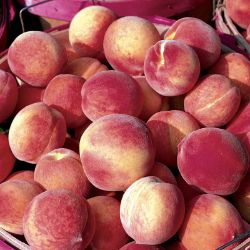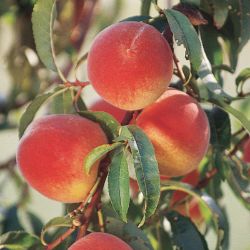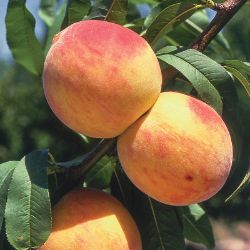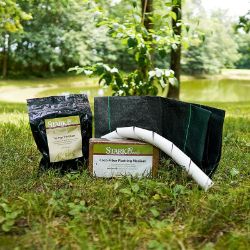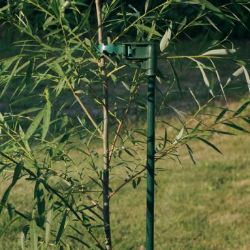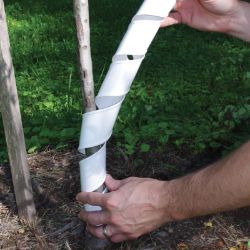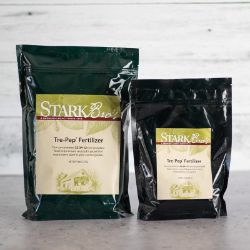Spraying Peach Trees
First and foremost, be sure to familiarize yourself with the existing or potential pest and diseases issues for peach trees in your area. Your local county Cooperative Extension is an excellent resource. Documents for identification and control, assembled by your local state universities, may even already exist online. Your local independent garden centers and local growers are also invaluable sources of pest and disease control in your area.
In high-density orchards, a proper and consistent spray schedule can be paramount to the survival of your peach tree. Many potential issues can be prevented with sprays before they become problematic. To get the most return on the investment of your money, time and energy, spraying peach trees should be done consistently and thoroughly, following the guidelines below.
NOTE: This is part 9 in a series of 11 articles. For a complete background on how to grow peach trees, we recommend starting from the beginning.
Before you begin, read and follow all instructions on the labels of the products. Do not combine any chemicals unless the labels on each chemical spray involved specifically state that you can safely do so.
A well-rounded home spray program for peach trees includes dormant-season as well as growing-season sprays for pests and diseases. Research your location and learn about any pests or diseases that frequently occur where you live. If you know peach tree diseases are common in your area, planting easy-care, disease-resistant peach trees may give you an advantage.
Note: Contact your local county Cooperative Extension for alternative suggestions and advice on cultural and chemical control methods if certain sprays offered by Stark Bro’s are not recommended for use in your area.
When to Spray Peach Trees
- Dormant Season (late winter/early spring, before bud break)
- Growing Season: Bud Break (emergence of new growth)
- Growing Season: After Blossom (after petals drop*)
*gives bees and other beneficials a chance to safely pollinate the blossoms
It bears repeating: Always follow instructions printed on the label for more detailed information about timing and application methods.
Pest Control Sprays:
Monterey Horticultural Oil
- Pests: Aphids, mites, scale, whiteflies, sawflies, loopers, leafhoppers, leafminers, leafrollers, psylla, mealybugs, thrips, worms, and more.
- Diseases: Black spot, powdery mildew, rust, sooty mold
- Timing: Growing Season – Pre-Bloom, Growing Season – After Blossom, Dormant Season
- Type: Mainly preventative. Controls overwintering pests and their eggs.
- Application: Follow the label. Apply as directed, as needed. Do not apply when temperatures are below 32ºF (no heat restriction for use – unique for an oil spray). Do not apply during drought or to wilted or otherwise stressed plants. Test for plant sensitivity prior to broad use.
Hi-Yield® Vegetable & Ornamental Insect Control
- For: Ants, cutworms, crickets, earwigs, grasshoppers, grubs, seed maggots, weevils, and wireworms.
- Timing: Growing Season – After Blossom
- Type: Active. Controls pests on contact. Pests must be present for to be effective.
- Application: Follow the label. Apply as directed, every 7 days as needed. Can be applied up to 7 days before harvest.
Safer® Brand Insect Killing Soap
- For: Aphids, earwigs, grasshoppers, harlequin bugs, leafhoppers, mealybugs, mites, plant bugs, psyllids, sawfly larvae, soft scales, spider mites, squash bugs, blossom thrips, and whiteflies.
- Timing: Growing Season – After Blossom
- Type: Mainly active. Controls pests on contact. Pests must be present for spray to be effective. This OMRI Listed® insect killer is compliant for use in organic gardening.
- Application: Follow the label. Apply as directed. Apply every 5 to 7 days when insects are present. Can be used up to the day of harvest.
Natural Guard® Caterpillar Killer Spray w/BT
- For: Pests treated include bagworms, tent caterpillars, gypsy moths, cabbage loopers, and tomato hornworms.
- Timing: Growing Season – Bud Break or After Blossom
- Type: Active. Controls pests on contact. Pests must be present for spray to be effective.
- Application: Follow the label. Apply this product when worms or caterpillars are first noticed, then repeat at five (5) to seven (7) day intervals while they are active. May be applied up to and including the day of harvest.
GardenTech® Sevin® Bug Killer
- For: Apple aphid, apple maggot, apple mealybug, apple pandemic, apple rust mite, apple sucker, avocado leafroller, bagworms, black cherry aphid, black scale, leafrollers, lecanium scales, lesser appleworm, lesser peachtree borer, meadow spittlebug, omnivorous leaftier, strawberry fruitworm, orange tortrix
- Timing: Growing Season – After Blossom
- Type: Active. Controls pests on contact. Pests must be present for spray to be effective.
- Application: Follow the label. To avoid fruit drop, apply 30 days after full bloom. Apply as directed, every 7 days, up to 8 times per year (max) as needed. Can be applied up to 3 days before harvest.
Disease Control Sprays
Hi-Yield® Captan 50W Fungicide
- For: Controls fungus diseases such as black rot, botrytis rot, brown rot, scab, and leaf spot on fruits and ornamental plants. Hi-Yield Captan is also excellent to control cedar apple rust on fruit trees.
- Timing: Growing Season – Bud Break (pre-bloom, bloom, petal fall), Growing Season – After Blossom
- Type: Mainly active, also preventative. Controls and prevents fungal diseases.
- Application: For application rates consult the label on listed fruits and ornamentals. May be applied up to day of harvest.
Monterey Liquid Copper Fungicide
- For: Powdery Mildew, Rusts, Black Spot, Leaf & Fruit Spot, Downy Mildew, Fruit Rot, Late Blight, and Leaf Curl.
- Timing: Use while plants are dormant and throughout the growing season.
- Type: Mainly active, also preventative. Controls and prevents fungal diseases. OMRI certified organic.
- Application: Follow the label. Apply as directed. Can be used up to the day of harvest.
Ferti-lome® Broad Spectrum Landscape & Garden Fungicide
- For: Botrytis (leaf blight, blast, vine rot), purple blotch, neck rot, downy mildew (suppression), early/late blight, leafspots and foliar blights (including: anthracnose, black spot, botrytis, shothole, fusarium leafspot, twig blight, brown rot, scab, stagonospora leaf scorch, etc.), flower spots and blights (including: botrytis flower spot, flower blight, etc.), stem canker, stem end rot, phytophthora (leaf blight, dieback), powdery mildew, rust (cedar apple rust, cedar hawthorn rust, cedar quince rust, etc.), mummy berry, eastern filbert blight, leaf curl, shothole (coryneum blight), lacy scab (russet) – and more
- Timing: Growing Season – Bud Break (avoid use during bloom period to prevent injury), Growing Season – After Blossom
- Type: Mainly active. Controls fungal diseases.
- Application: Follow the label. Apply as directed (interval varies) as needed. Avoid spraying plants during extremely hot and sunny weather. Do not apply within one week before or after application of an oil/oil-based pesticide.
Combination Sprays for Pests & Diseases
Natural Guard® Neem
- Pests: Aphids, spider mites, scale, whiteflies, beetles, leafrollers, and other insect pests.
- Diseases: Powdery mildew, black spot, downy mildew, anthracnose, rust, leaf spot, botrytis, needle rust, scab and flower, twig and tip blight, and alternaria.
- Timing: Dormant Season, Growing Season – Bud Break, Growing Season – After Blossom
- Type: Mainly preventative, also active. Controls overwintering pests and their eggs, and pests on contact. Controls and prevents fungal diseases.
- Application: Follow the label. Oil-based, so apply in early morning/late evening to minimize the potential for leaf burn. Apply as directed, every 7- to 14-days as needed. Can be used up to the day of harvest.
Monterey Fruit Tree Spray Plus
- Pests: Aphids, mites, scale, whiteflies, beetles, leafrollers, loopers, mealybugs, leafhoppers, leafminers, thrips, borers, grasshoppers, crickets, ants, hornworm, earwig, chiggers, worms, and other insect pests.
- Diseases: Powdery mildew, black spot, brown spot, dollar spot, snow mold, downy mildew, anthracnose, rust, leaf spot, botrytis, needle rust, blight (flower blight, twig blight, and tip blight), scab.
- Timing: Growing Season – Pre-Bloom (for early disease prevention), Growing Season – After Blossom (for pest and disease control on contact).
- Type: Mainly active, also preventative. Controls pests on contact. Pests must be present for spray to be effective. Controls and prevents fungal diseases.
- Application: Follow the label. Apply as directed, every 7 to 14 days, as needed. Do not use more than 1 time per day on the same plants. Do not use more than 10 times per season. Do not apply when temperatures are below 45ºF. Do not apply to wilted or otherwise stressed plants. Apply in early morning or late evening to minimize potential for leaf burn. Test for plant sensitivity prior to broad use.
Monterey Horticultural Oil
- Pests: Aphids, mites, scale, whiteflies, sawflies, loopers, leafhoppers, leafminers, leafrollers, psylla, mealybugs, thrips, worms, and more.
- Diseases: Black spot, powdery mildew, rust, sooty mold
- Timing: Growing Season – Pre-Bloom, Growing Season – After Blossom, Dormant Season
- Type: Mainly preventative. Controls overwintering pests and their eggs.
- Application: Follow the label. Apply as directed, as needed. Do not apply when temperatures are below 32ºF (no heat restriction for use – unique for an oil spray). Do not apply during drought or to wilted or otherwise stressed plants. Test for plant sensitivity prior to broad use.















